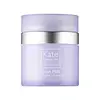What's inside
What's inside
 Key Ingredients
Key Ingredients

 Benefits
Benefits

 Concerns
Concerns

 Ingredients Side-by-side
Ingredients Side-by-side

Water
Skin ConditioningDisodium Laureth Sulfosuccinate
CleansingOctyldodecanol
EmollientPolyacrylate-33
Propanediol
SolventPolyglyceryl-2 Caprate
EmulsifyingSodium Cocoyl Isethionate
CleansingMontmorillonite
AbsorbentKaolin
AbrasiveOlive Oil Polyglyceryl-6 Esters
EmollientRice Oil Glycereth-8 Esters
CleansingPhospholipids
Skin ConditioningSodium Lauroamphoacetate
CleansingBisabolol
MaskingPentylene Glycol
Skin ConditioningSodium Chloride
MaskingSodium Phytate
Caprylyl Glycol
EmollientDehydroacetic Acid
PreservativeBenzoic Acid
MaskingPropylene Carbonate
SolventLinalool
PerfumingFarnesol
PerfumingWater, Disodium Laureth Sulfosuccinate, Octyldodecanol, Polyacrylate-33, Propanediol, Polyglyceryl-2 Caprate, Sodium Cocoyl Isethionate, Montmorillonite, Kaolin, Olive Oil Polyglyceryl-6 Esters, Rice Oil Glycereth-8 Esters, Phospholipids, Sodium Lauroamphoacetate, Bisabolol, Pentylene Glycol, Sodium Chloride, Sodium Phytate, Caprylyl Glycol, Dehydroacetic Acid, Benzoic Acid, Propylene Carbonate, Linalool, Farnesol
Water
Skin ConditioningEthylhexyl Palmitate
EmollientMyristyl Myristate
EmollientGlyceryl Stearate
EmollientPEG-100 Stearate
Cetearyl Ethylhexanoate
EmollientDecyl Oleate
EmollientGlycerin
HumectantPropanediol
SolventGoat Milk
Skin ConditioningLactose
HumectantMilk Protein
Skin ConditioningHelianthus Annuus Seed Oil
EmollientHamamelis Virginiana Flower Water
AstringentCocos Nucifera Oil
MaskingPersea Gratissima Oil
Skin ConditioningSimmondsia Chinensis Seed Oil
EmollientVitis Vinifera Seed Oil
EmollientAloe Barbadensis Leaf Juice Powder
Skin ConditioningOryza Sativa Bran Extract
Skin ConditioningRosmarinus Officinalis Leaf Extract
AntimicrobialTocopheryl Acetate
AntioxidantTocopherol
AntioxidantCaprylyl Glycol
EmollientAcrylates/C10-30 Alkyl Acrylate Crosspolymer
Emulsion StabilisingPhenoxyethanol
PreservativeEthylhexylglycerin
Skin ConditioningHexylene Glycol
EmulsifyingXanthan Gum
EmulsifyingAminomethyl Propanol
BufferingDisodium EDTA
Lactic Acid
BufferingBenzoic Acid
MaskingWater, Ethylhexyl Palmitate, Myristyl Myristate, Glyceryl Stearate, PEG-100 Stearate, Cetearyl Ethylhexanoate, Decyl Oleate, Glycerin, Propanediol, Goat Milk, Lactose, Milk Protein, Helianthus Annuus Seed Oil, Hamamelis Virginiana Flower Water, Cocos Nucifera Oil, Persea Gratissima Oil, Simmondsia Chinensis Seed Oil, Vitis Vinifera Seed Oil, Aloe Barbadensis Leaf Juice Powder, Oryza Sativa Bran Extract, Rosmarinus Officinalis Leaf Extract, Tocopheryl Acetate, Tocopherol, Caprylyl Glycol, Acrylates/C10-30 Alkyl Acrylate Crosspolymer, Phenoxyethanol, Ethylhexylglycerin, Hexylene Glycol, Xanthan Gum, Aminomethyl Propanol, Disodium EDTA, Lactic Acid, Benzoic Acid
 Reviews
Reviews

Ingredients Explained
These ingredients are found in both products.
Ingredients higher up in an ingredient list are typically present in a larger amount.
Benzoic Acid is used to preserve and adjust the pH of products.
The antimicrobial property of Benzoic Acid helps elongate a product's shelf life. Its main role is to reduce fungi growth and is not found to be effective at fighting bacteria. Therefore Benzoic Acid is always added along with other preservatives.
In its pure form, Benzoic Acid looks like a white crystalline solid. It has slight solubility in water.
The name of Benzoic Acid comes from gum benzoin, which used to be the sole source of deriving this ingredient. Benzoic Acid is the most simple aromatic carboxylic acid.
Benzoic Acid is naturally occuring in strawberries, mustard, cinnamon, and cloves. It has a slight scent but is not considered to be a fragrance.
Learn more about Benzoic AcidCaprylyl Glycol is a humectant and emollient, meaning it attracts and preserves moisture.
It is a common ingredient in many products, especially those designed to hydrate skin. The primary benefits are retaining moisture, skin softening, and promoting a healthy skin barrier.
Though Caprylyl Glycol is an alcohol derived from fatty acids, it is not the kind that can dry out skin.
This ingredient is also used as a preservative to extend the life of products. It has slight antimicrobial properties.
Learn more about Caprylyl GlycolPropanediol is an all-star ingredient. It softens, hydrates, and smooths the skin.
It’s often used to:
Propanediol is not likely to cause sensitivity and considered safe to use. It is derived from corn or petroleum with a clear color and no scent.
Learn more about PropanediolWater. It's the most common cosmetic ingredient of all. You'll usually see it at the top of ingredient lists, meaning that it makes up the largest part of the product.
So why is it so popular? Water most often acts as a solvent - this means that it helps dissolve other ingredients into the formulation.
You'll also recognize water as that liquid we all need to stay alive. If you see this, drink a glass of water. Stay hydrated!
Learn more about Water